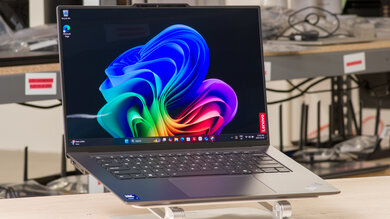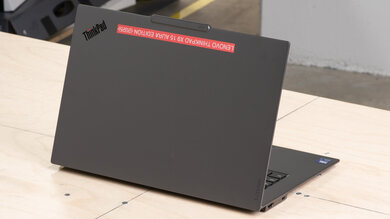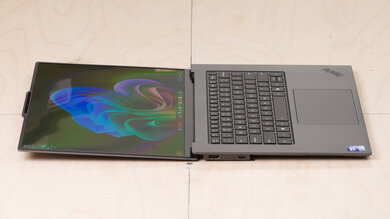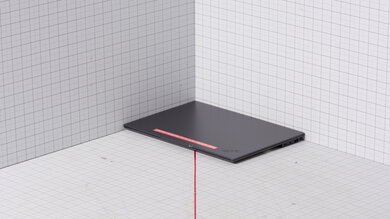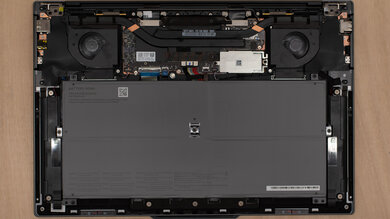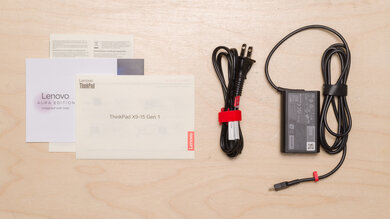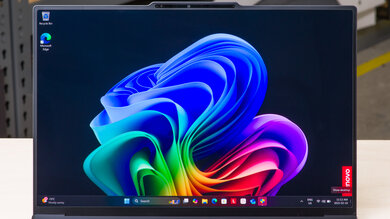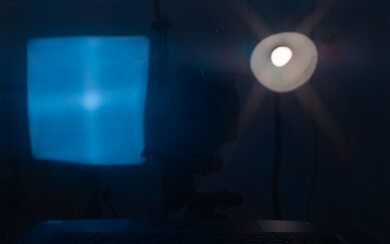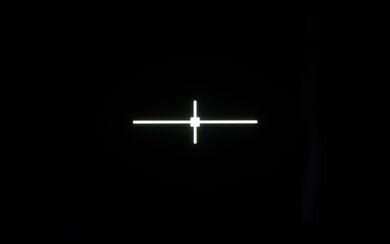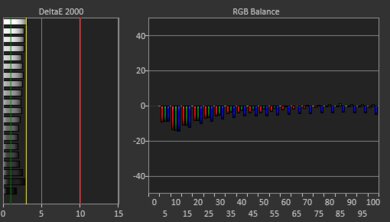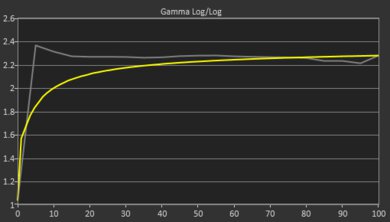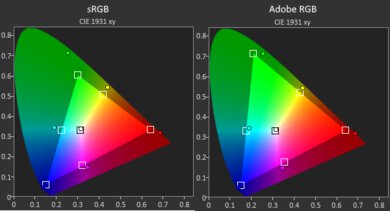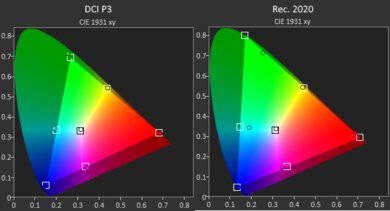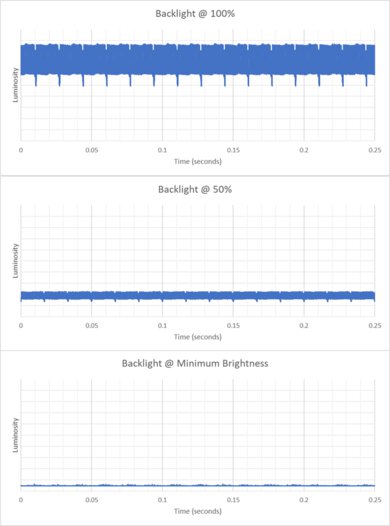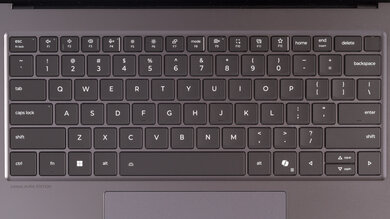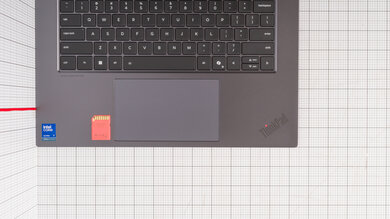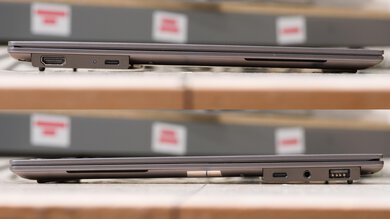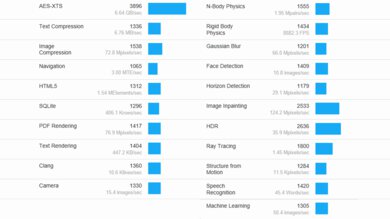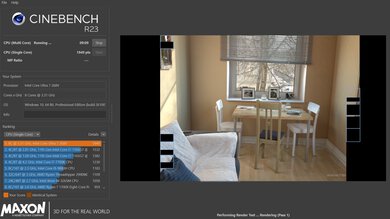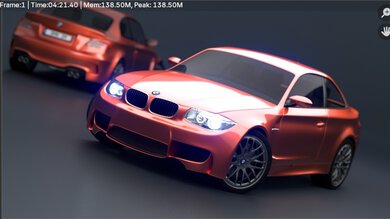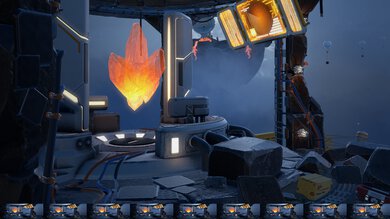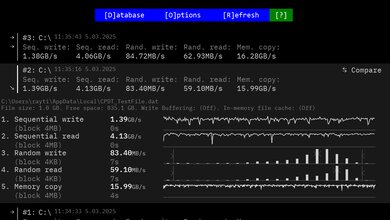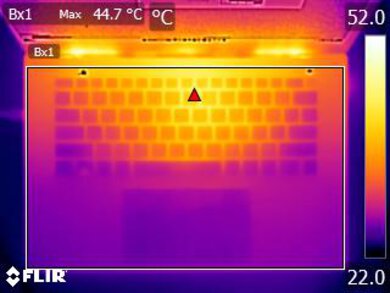The Lenovo ThinkPad X9 15 Aura Edition (2025) is a premium Windows laptop. This 15-inch ultraportable features Intel's Lunar Lake SoCs, with options ranging from a Core Ultra 5 226V to a Core Ultra 7 268V. You can get up to 32GB of soldered RAM and 2TB of storage. It has a 2.8k 120Hz OLED display (with or without touch input), a haptic touchpad, a 1440p webcam, and Wi-Fi 7 wireless connectivity. Ports include a USB-A, two USB-C/Thunderbolt 4s, an HDMI 2.0, and a headphone jack.
See our unit's specifications and the available configuration options in the Differences Between Variants section.
Note: We performed the productivity benchmarks, gaming benchmarks, thermals and noise, and performance over time tests using the Best Performance mode instead of the default Balanced mode. This change makes the results more representative of the laptop's maximum potential and brings them closer to user expectations. However, this also means that the results are only comparable with reviews containing this disclaimer, as we previously tested laptops in their default mode, which usually throttles performance to prolong battery life.
Our Verdict
The Lenovo ThinkPad X9 is excellent for school use. It has a thin and light design that makes it easy to carry around, and its battery lasts around 15 hours in light uses, so you don't have to worry about bringing a charger. The overall user experience is amazing, as it sports a sharp OLED display that gets bright enough to combat glare, a comfortable keyboard, and a large, easy-to-use haptic touchpad. Its Intel SoC can easily handle general productivity workloads like web browsing, text processing, and video playback. You can do some moderately intensive tasks like programming and photo editing, but students in programs like 3D animation or simulations are better off getting a workstation or gaming laptop with a more powerful CPU and discrete GPU.
-
Thin and light design.
-
All-day battery life.
-
Bright, colorful OLED display.
-
Comfortable keyboard, responsive haptic touchpad.
-
Doesn't get overly hot or loud under load.
-
CPU and integrated GPU can't handle highly demanding workloads.
-
OLED is susceptible to permanent burn-in.
-
OLED display's 480Hz flicker may bother some people.
The Lenovo ThinkPad X9 isn't designed for gaming. While its Lunar Lake SoC's integrated GPU can handle some demanding games at 1080p with low settings, you'll likely come across a lot of titles that are simply too intensive to run smoothly. Its OLED display is pretty good, sporting a 120Hz refresh rate and a fast response time; however, it doesn't support FreeSync or G-SYNC, which means you'll still see some screen tearing when gaming. In short, this laptop is fine for casual gaming, but it isn't ideal if your primary goal is to play demanding AAA titles.
-
120Hz display with fast response time.
-
Minimal thermal throttling.
-
Doesn't get overly hot or loud under load.
-
CPU and integrated GPU can't handle highly demanding workloads.
-
Can only get up to 32GB of soldered RAM.
-
OLED display's 480Hz flicker may bother some people.
The Lenovo ThinkPad X9 is excellent for media consumption. This 15-inch laptop is very portable, thanks to its compact design, and with a battery that lasts nearly 19 hours of video playback, you can easily get through multiple movies and TV show episodes without reaching for the charger. Its OLED display looks sharp and colorful, and like all OLEDs, it produces deep, inky blacks, making it fantastic for dark room viewing and HDR content. The OLED display flickers at 480Hz, though, so it may cause some eye strain if you're sensitive to flickering. The speakers sound clear and well-balanced, with a good amount of bass. They get loud, too, but they distort a bit at higher volume levels.
-
Thin and light design.
-
All-day battery life.
-
Bright, colorful OLED display.
-
Loud, well-balanced sounding speakers.
-
Available with touch-sensitive display.
-
OLED is susceptible to permanent burn-in.
-
OLED display's 480Hz flicker may bother some people.
The Lenovo ThinkPad X9 isn't ideal for use as a workstation. Its Intel Lunar Lake SoC is a low-power chip that can only handle light to moderately demanding tasks. Also, you can only get up to 32GB of soldered RAM, which isn't enough for highly intensive workloads. You can do some color-correction work, though, as its 2.8k OLED display has full DCI P3 and near-full Adobe RGB coverage. Thermal throttling is minimal, and the laptop doesn't get hot or loud under load.
-
Display is suitable for color-critical work.
-
Great port selection incldues two Thunderbolt 4s and an HDMI.
-
Minimal thermal throttling.
-
Doesn't get overly hot or loud under load.
-
CPU and integrated GPU can't handle highly demanding workloads.
-
Can only get up to 32GB of soldered RAM.
-
OLED is susceptible to permanent burn-in.
-
OLED display's 480Hz flicker may bother some people.
The Lenovo ThinkPad X9 is excellent for business use. It has a sturdy all-aluminum build, a thin and light design, and a battery that lasts easily through a typical workday, making it a near-perfect device for those who travel a lot for work. It's also a joy to work on, thanks to its sharp OLED display, comfortable keyboard, easy-to-use haptic touchpad, and excellent webcam. Biometrics include a fingerprint sensor and a facial recognition IR camera, which is great if you want to avoid typing in your password in public spaces. Performance is great; its Intel Lunar lake SoC can easily handle productivity tasks like text processing, web browsing, spreadsheets, and presentations. Its OLED display flickers, though, which might bother people sensitive to flickering, causing eye strain. Additionally, it's susceptible to permanent burn-in, so you'll want to take active measures to prevent it if you plan to keep the laptop for a while, like hiding Windows' taskbar.
-
Thin and light design.
-
All-day battery life.
-
Bright, colorful OLED display.
-
Comfortable keyboard, responsive haptic touchpad.
-
Excellent 1440p webcam.
-
OLED is susceptible to permanent burn-in.
-
OLED display's 480Hz flicker may bother some people.
- 9.0 School
- 7.7 Gaming
- 8.8 Multimedia
- 8.4 Workstation
- 8.6 Business
Changelog
- Updated May 07, 2025: We've updated this review to Test Bench 0.8.3, which removes the viewing angle tests and adds a GPU Total Graphics Power comparison in the GPU section. The Pen Input test in the Extra Features section has also changed, as it now shows whether the laptop supports pen input rather than the inclusion of a stylus in the box. See the changelog for more details.
- Updated Mar 24, 2025: Review published.
- Updated Mar 19, 2025: Early access published.
- Updated Feb 24, 2025: Our testers have started testing this product.
- Updated Feb 17, 2025: The product has arrived in our lab, and our testers will start evaluating it soon.
Differences Between Sizes And Variants
We tested the Lenovo ThinkPad X9 15 Aura Edition (model 21Q6-002BUS) with a touch-sensitive 2.8k OLED display, an Intel Core Ultra 7 268V SoC, 32GB of RAM, and 1TB of storage. The display, SoC, memory, and storage are configurable; see the available options below. This review applies to all variants with a model number starting with '21Q6.'
SCREEN
- 15.3" OLED 2880 x 1800 120Hz (glossy, 500 cd/m², 100% DCI P3)
- 15.3" OLED 2880 x 1800 120Hz (touchscreen, glossy, 500 cd/m², 100% DCI P3)
SoC
- Intel Core Ultra 5 226V (8 cores/8 threads, up to 4.5GHz, 8MB cache, Arc Graphics 130V)
- Intel Core Ultra 5 228V (8 cores/8 threads, up to 4.5GHz, 8MB cache, Arc Graphics 130V)
- Intel Core Ultra 5 238V (8 cores/8 threads, up to 4.7GHz, 8MB cache, Arc Graphics 140V)
- Intel Core Ultra 7 258V (8 cores/8 threads, up to 4.8GHz, 12MB cache, Arc Graphics 140V)
- Intel Core Ultra 7 268V (8 cores/8 threads, up to 5GHz, 12MB cache, Arc Graphics 140V)
MEMORY
- 16GB LPDDR5x 8533MHz (Core Ultra 5 226V only)
- 32GB LPDDR5x 8533MHz (Core Ultra 5 228V, Core Ultra 5 238V, Core Ultra 7 258V, Core Ultra 7 268V)
STORAGE
- 256GB M.2 2242 PCIe Gen 4 NVMe SSD
- 512GB M.2 2242 PCIe Gen 4 NVMe SSD
- 1TB M.2 2242 PCIe Gen 4 NVMe SSD
- 2TB M.2 2242 PCIe Gen 4 NVMe SSD
COLOR
- Gray
See our unit's label.
Popular Laptops Comparisons
The Lenovo ThinkPad X9 is among the best Windows ultraportable laptops currently on the market, rivaling competing premium models like the Microsoft Surface Laptop 7th Edition 15 (2024) and the Apple MacBook Air 15 (2024) in build quality, battery life, and overall user experience. Its Intel Lunar Lake SoC performs well and is likely more than adequate for most people with a light to moderately demanding productivity workload, though it's a little behind Apple's M3 SoC in single-thread performance and the Surface Laptop's Snapdragon X Elite SoC's in multi-thread performance. The X9's OLED display is arguably better than the MacBook Air and Surface Laptop's IPS panels due to its significantly higher contrast ratio, but keep in mind that its 480Hz flicker might bother some people, and it's susceptible to permanent burn-in, especially with static content like Windows' taskbar.
For more options, check out our recommendations for the best lightweight laptops, the best laptops for business, and the best 15- and 16-inch laptops.
The Apple MacBook Air 15 (M4, 2025) and the Lenovo ThinkPad X9 15 Aura Edition (2025) are premium ultraportables. While both laptops provide outstanding user experiences, the Lenovo has the edge. It has a wider port selection with an HDMI port and USB-A, a longer battery life, and arguably a better display. The Lenovo's OLED display is sharper, has a higher 120Hz refresh rate, and has a vastly superior contrast ratio, so blacks don't appear gray in dim settings. Just know that its 480Hz flicker might bother some people, and it's susceptible to permanent burn-in. On the other hand, the Apple M4 SoC delivers better performance in intensive tasks, and the fanless design means you don't need to worry about noise.
The Lenovo ThinkPad X9 15 Aura Edition (2025) and the Microsoft Surface Laptop 7th Edition 15 (2024) are both premium Windows ultraportables that deliver a similar user experience overall. The main difference between these two models is that the ThinkPad uses an x86 Intel SoC, while the Surface Laptop uses an AMR-based Qualcomm Snapdragon SoC. This likely won't affect you if you only perform light productivity tasks, but if you use any third-party program, it's best to check for compatibility first, as many apps don't run on the Surface's Arm-based chip or will perform poorly via emulation. Another significant difference is the display type; the ThinkPad's OLED panel is visually more pleasing because it can produce deeper blacks, but unlike the Surface's IPS panel, it's susceptible to permanent burn-in, and its 480Hz flicker can bother some people, causing eye strain.
The Lenovo ThinkPad X9 15 Aura Edition (2025) and the Lenovo Yoga Slim 7i Aura Edition (2024) are both ultraportables featuring Intel Lunar Lake chips, delivering nearly identical performance. However, the ThinkPad X9 is an even more premium device, sporting a sturdier build, a haptic touchpad, and a better 1440p webcam. The X9 also has a better battery life, lasting nearly four hours longer in light uses. That said, if you're sensitive to display flicker, know that the X9 is only available with OLED displays that flicker at 480Hz, while the Yoga Slim 7i has a flicker-free IPS panel option.
The Lenovo ThinkPad X9 15 Aura Edition (2025) and the HP OmniBook Ultra Flip 14 (2024) are both premium Windows laptops. However, the ThinkPad is a 15-inch clamshell model, while the OmniBook is a 14-inch 2-in-1 convertible. Although both laptops sport a 2.8k OLED display, the ThinkPad's panel gets brighter and is better at reducing bright reflections, making it ideal for well-lit environments. The ThinkPad also has a more comfortable keyboard with more key travel, a wider port selection, and a longer battery life.
The Apple MacBook Air 13 (M4, 2025) and the Lenovo ThinkPad X9 15 Aura Edition (2025) are both premium ultraportables that provide an excellent user experience overall. Each has its pros and cons. The Lenovo has a USB-A and an HDMI port, which the MacBook Air lacks, and it supports the latest Wi-Fi 7 wireless connectivity, while the MacBook Air only has Wi-Fi 6E. The Lenovo's OLED display is arguably better since it has a 120Hz refresh rate and can produce deeper blacks, but know that it has a 480Hz flicker that might bother some people, causing eye strain. OLEDs are also susceptible to permanent burn-in, so you'll have to take active measures to prevent it, like hiding Windows' taskbar. On the other hand, the MacBook Air is more portable, and its fanless design means you'll never have to deal with fan noise.
The Lenovo ThinkPad X9 15 Aura Edition (2025) and the Framework Laptop 13 (2025) are ultraportable Windows Laptops. The Framework has a fully modular design with interchangeable I/O ports and replaceable internal components, while the Lenovo has soldered, non-replaceable parts. The Lenovo has a 120Hz OLED display with an optional touchscreen with an infinite contrast ratio, while the Framework is only available with IPS, non-touch displays. That said, the Lenovo's display flickers at a 480Hz frequency that could be distracting to some people. Both laptops have great build quality, but the Lenovo feels more premium.
The Lenovo ThinkPad X9 15 Aura Edition (2025) is better than the Dell XPS 13 (2024) for most uses. The ThinkPad X9 has a wider port selection that includes a USB-A and an HDMI, which the XPS lacks, and its battery life is significantly longer, lasting nearly six hours more in light uses. It also provides a better user experience overall, as the XPS' zero-lattice keyboard, capacitive function row, and invisible touchpad can take much longer to get used to. Performance-wise, while the ThinkPad X9's Intel Lunar Lake SoC isn't as fast as the XPS' Meteor Lake chip in multi-threaded workloads, its stronger single-thread performance will contribute to a snappier desktop experience, and its improved graphical performance will allow you to play more games.
The Lenovo ThinkPad X9 15 Aura Edition (2025) and the Apple MacBook Air 15 (2024) are both premium ultraportables that provide an amazing user experience overall. The ThinkPad X9 has a wider port selection with the inclusion of a USB-A and HDMI port, and its battery life is better, lasting nearly three hours longer in light uses. It also has a user-replaceable SSD, and its keyboard feels more comfortable to type on, as it has more key travel and doesn't feel as harsh when you bottom out. The ThinkPad X9's OLED display is arguably better than the MacBook Air's Retina screen, thanks to its much higher contrast ratio and 120Hz refresh rate, but keep in mind that its 480Hz flicker might bother some people, and it's susceptible to permanent burn-in. On the other hand, the MacBook Air is a fanless device, so you'll never have to deal with fan noise.
Test Results
The Lenovo ThinkPad X9 is only available in Gray. See the bottom of the laptop.
The Lenovo ThinkPad X9's build quality is outstanding. Its full-aluminum chassis feels very sturdy—not quite as rigid as, say, the Apple MacBook Pro 14 (2024), but pretty close, exhibiting very little flex on the lid and keyboard deck. The finish doesn't scratch easily; it picks up some fingerprints and smudges, which you can wipe off with a microfiber cloth with relative ease, though this will likely be a little harder as the smudges accumulate with more regular use. The feet feel solid and stick firmly to the bottom.
The hinge is outstanding. It feels smooth when opening and closing the lid, and it's very stable, exhibiting only a small amount of wobble when typing heavily. The range doesn't quite reach 180°, so you can't lay the screen completely flat on the table, but the angle is likely good enough that you can easily share content with someone sitting opposite you.
Accessing the Lenovo ThinkPad X9's internals is very easy; you only need to remove six Philips screws and release the bottom panel's clips—a prying tool isn't necessary. The screws are captive, meaning they remain attached to the bottom panel, so you don't have to worry about losing them. The storage slot supports M.2 2242 PCIe Gen 4 NVMe SSDs.
Get Lenovo's official user maintenance guide.
The Lenovo ThinkPad X9 is available with the following displays:
- 15.3" OLED 2880 x 1800 120Hz (touchscreen, glossy, 100% DCI P3)
- 15.3" OLED 2880 x 1800 120Hz (glossy, 100% DCI P3)
The two available displays are identical; the only difference is that one has touch input support. Both panels look very sharp, with a pixel density in the same ballpark as the Apple MacBook Air 13 (2024)'s Retina display. The 16:10 aspect ratio is well-suited for productivity; it gives you more vertical space than a standard 16:9 screen, allowing you to see more information at once when reading a document, so you don't have to scroll as much. The downside is that you'll almost always have black bars at the top and bottom when watching standard 16:9 videos.
The display's 120Hz refresh rate helps provide a better user experience than a standard 60Hz display, as it makes motion look smoother, like when scrolling through a document, and improves input responsiveness. However, setting the refresh rate to 120Hz will drain the battery faster. You can set it to a fixed 60Hz to save battery, and there's also a Dynamic Refresh Rate setting that automatically switches the refresh rate between 60Hz and 120Hz, depending on whether you're actively using the laptop or looking at static content. Dynamic Refresh Rate isn't the same as FreeSync or G-SYNC, though, so you'll likely still see screen tearing when gaming.
The display is bright enough for use in most indoor settings. Outdoor use is possible, but you may have trouble seeing some content under direct sunlight. It gets very dim at the lowest brightness setting, which is great for dark room viewing as it causes less eye strain.
The display handles reflections well. Its glossy finish mainly struggles with bright light sources, like a lamp or open window during the day. These reflections are visible even when viewing light-color content with the screen at maximum brightness, but they aren't overly distracting.
The display's out-of-the-box accuracy is decent. The white balance inaccuracies are relatively minor and hard to spot, and the color temperature is very close to the standard 6500K target. Color accuracy depends on the selected color profile. The display uses the DCI P3 color space when there isn't an active color profile, resulting in a high dE (due to oversaturation). Switching to the Default color profile results in nearly identical measurements. You can set the color profile via the X-Rite Color Assistant app; here are the measurements in the sRGB, DCI P3, and Adobe RGB color profiles:
sRGB
DCI P3
Adobe RGB
The display's color gamut is superb. It has full coverage of the sRGB and DCI P3 color spaces, as well as near-full coverage of the Adobe RGB color space. This panel is suitable for media consumption and color-critical work like photo and video editing. The regular, non-touch display has the same advertised color gamut.
The Lenovo ThinkPad X9 has an excellent keyboard. It has a spacious, relatively standard layout that's easy to get used to. The keys are mostly stable—only a few exhibits some wobbling. While the key travel is a tad shorter than most Lenovo ThinkPads, the overall typing experience is still excellent, as the keys are easy to actuate and provide a good amount of tactile feedback. There's some padding to provide a softer feel when bottoming out, but you still get a satisfying yet quiet thump when you reach the bottom. You can toggle between two backlight brighness levels using FN + Spacebar or turn it off completely. The backlight is white, leaning on the cooler side.
The Lenovo ThinkPad X9 has an outstanding touchpad. It's large and responsive to all movements and gestures. Palm rejection works as intended, and there are no issues with actions like dragging and dropping or zooming in and out of images. This is a haptic touchpad, so you can click anywhere. The haptic engine could use a little tuning, though, as the tactile feedback is quite subtle.
One notable design change compared to other ThinkPads is that there's no Trackpoint on this laptop. How do you feel about the removal of such an iconic feature? And is it a dealbreaker? Let us know in the discussions below.
The Lenovo ThinkPad X9 has great speakers that are among the better ones you can find in the Windows world. They sound clear, full, and well-balanced, with a good amount of bass. They get very loud, though there's a bit of distortion at higher volume levels.
The Lenovo ThinkPad X9 has an excellent webcam. Though a tad overexposed, the image looks clear and detailed, with true-to-life colors. There's some noise here and there, but not enough to impact the overall video quality. As for the microphone, voices sound clear, albeit a little boxy and on the quieter side. There's no physical privacy cover; you can only disable the camera at the software level using the F9 shortcut.
The Lenovo ThinkPad X9 has a great port selection. The USB-A supports USB 3.2 Gen 2 data transfer speed of up to 10Gbps and is always on, meaning you can use it to charge a mobile device even when the laptop is in sleep mode. Both USB-Cs support Thunderbolt 4 (up to 40Gbps data transfer speed and two 4k displays @ 60Hz), DisplayPort 2.1, and Power Delivery. Lenovo advertises HDMI 2.1 support; however, the HDMI port can only output a maximum resolution of 4k @ 60Hz. As such, we consider it an HDMI 2.0.
The Lenovo ThinkPad X9's wireless adapter is an Intel Wi-Fi 7 BE201. Like Wi-Fi 6E, Wi-Fi 7 gives you access to the 6GHz band but with even faster speeds and lower latency. However, you need a router that supports Wi-Fi 7 to benefit from these features. See our best router recommendations if you want to upgrade your home Wi-Fi.
The Lenovo ThinkPad X9 is available with the following CPUs:
- Intel Core Ultra 5 226V (8 cores/8 threads, up to 4.5GHz, 8MB cache)
- Intel Core Ultra 5 228V (8 cores/8 threads, up to 4.5GHz, 8MB cache)
- Intel Core Ultra 5 238V (8 cores/8 threads, up to 4.7GHz, 8MB cache)
- Intel Core Ultra 7 258V (8 cores/8 threads, up to 4.8GHz, 12MB cache)
- Intel Core Ultra 7 268V (8 cores/8 threads, up to 5GHz, 12MB cache)
These are low-power processors designed for general productivity tasks like web browsing, text processing, spreadsheets, and video playback. Unlike their Meteor Lake predecessors, these Lunar Lake processors are proper SoCs (System on Chip) with the RAM built in. This change limits the RAM configuration, meaning you can only get 16GB of RAM with the Core Ultra 5 226V, while the 32MB memory configuration is only possible if you upgrade to one of the remaining four options (Core Ultra 5 228V, Core Ultra 238V, Core Ultra 7 258V, or Core Ultra 7 268V). Another significant change compared to the previous generation of Intel CPUs is the lack of Hyper-Threading, resulting in slightly slower multi-thread performance.
All five SoCs have the same core count and composition: four performance and four efficiency cores. There's a performance difference between these chips, but it's relatively minute (around 5% to 10% difference between the low-end Core Ultra 5 226V and the top-end Core Ultra 7 268V) and hard to notice in light, general productivity workloads. Finally, all four SoCs have an NPU (Neural Processing Unit) to handle AI tasks, like Windows Copilot, image generation in photo editing apps, and background-blurring on video calls. The Core Ultra 5s' NPU has a rated performance of 40 TOPS (Trillions of Operations per Second). The Core Ultra 7 258V has a rated performance of 47 TOPS, and the Core Ultra 7 268V has a rated performance of 48 TOPS.
You can see more information about the Lunar Lake SoCs in Intel's support page.
The Lenovo ThinkPad X9 is only available with integrated graphics. The Core Ultra 5s use the Intel Arc 130V GPU, while the Core Ultra 7s use the slightly faster Intel Arc 140V. Both are low-power GPUs designed for general productivity. These ARC GPUs are a step up in gaming performance compared to Intel's previous generation of integrated graphics, allowing you to play some moderately intensive games at 1080p (with low graphical settings), but they don't improve much in terms of raw computing power in productivity workloads. As for the difference between the 130V and 140V, the latter is roughly 17% to 20% faster in most instances.
You can configure the Lenovo ThinkPad X9 with 16GB or 32GB of RAM. The memory isn't user-replaceable.
You can configure the Lenovo ThinkPad X9 with 256GB, 512GB, 1TB, or 2TB of storage. The storage is user-replaceable; the slot supports M.2 2242 PCIe Gen 4 NVMe SSDs.
The Lenovo ThinkPad X9 with an Intel Core Ultra 7 268V SoC scores well in the Geekbench 5 benchmarks. Its strong single-thread performance is excellent, rivaling significantly more power-hungry CPUs like Intel's 14th Gen HX chips typically found in powerful gaming laptops and workstations. As for its multi-thread performance, while it's very good for a low-power chip and is more than adequate for this laptop's intended use (light, general productivity tasks), know that there are faster chips on the market, like the Microsoft Surface Laptop 7th Edition 15 (2024)'s Qualcomm Snapdragon X Elite.
Unfortunately, although the new Arc Graphics are better than previous generation integrated GPUs from Intel, they're still pretty weak compared to current-gen entry-level discrete GPUs, at least when it comes to non-gaming, computing tasks.
Below are additional benchmark scores in Geekbench 6 in case you're more familiar with those numbers:
- CPU Single-thread: 2,854
- GPU Multi-thread: 11,177
- GPU Compute: Not supported
The Lenovo ThinkPad X9's Intel Core Ultra 7 268V SoC performs relatively well in the Cinebench R23 benchmarks. This performance level is squarely in the premium ultraportable territory—good enough for light to moderately intensive workloads but not ideal for highly demanding tasks. For the latter, you're better off getting a workstation or gaming laptop with a more robust cooling system, like the Razer Blade 18 (2024) or the Apple MacBook Pro 16 (2024).
Here are additional benchmark numbers from Cinebench 2024 in case you're more familiar with them:
- Single-thread: 126
- Multi-thread: 576
The Intel Core Ultra 7 268V's integrated Arc Graphics 140V scores decently well in the Basemark GPU benchmarks. This performance level is roughly in the same ballpark as an NVIDIA GeForce GTX 1650 (mobile), an entry-level discrete GPU first launched in 2019. It can handle some demanding games at 1080p, though you'll have to lower the graphical settings to get playable frame rates. The Core Ultra 5's Arc Graphics 130V is weaker, so expect to get even lower frame rates.
We performed the web browsing and video playback tests using the default Balanced mode, and the gaming test using the Best Performance mode, as it's more representative of real-world usage.
Borderlands 3 runs poorly at 1080p on the Lenovo ThinkPad X9 with a Core Ultra 7 268V SoC. Although you can get over 60 fps with low settings, the gameplay is extremely choppy due to frame drops. Lowering the resolution to 720p will likely reduce the stuttering but won't completely fix it.
The Intel Lunar Lake SoCs can run Civilization VI and other similarly demanding strategy games smoothly at 1080p, as these types of games typically don't require a lot of GPU processing power. The average turn time is decent and within the expected range for a low-power, current-gen ultraportable CPU.
Counter-Strike 2 is playable at 1080p with some tweaks in the graphical settings, but you might experience some choppiness here and there, which isn't ideal for an FPS game.
Shadow of the Tomb Raider is somewhat playable at 1080p on the Lenovo ThinkPad X9. You can get close to 60 fps with the lowest graphical settings, but you'll likely experience some stutters due to frame drops in busy scenes. The large frametime spikes are scene changes and aren't representative of the performance.
The Lenovo ThinkPad X9's keyboard only gets mildly warm under load and likely won't cause any discomfort even though the hot spot is near the middle. Using the device on your lap isn't a problem, as the bottom of the laptop is cooler at 40.9 °C (105.62 °F). The fans are audible but relatively quiet; the noise isn't distracting, as it just sounds like heavy airflow.
The posted results are measurements taken in the Best Performance mode. You can change the performance mode via Windows' settings or the Lenovo Commercial Vantage app; the latter merely mirrors whichever mode you set in Windows' settings.
The Lenovo ThinkPad X9 has a few pre-installed applications, including:
- Lenovo AI NOW 1.2: AI software that can help with the PC setup process, summarize content, retrieve information, and generate text.
- Lenovo Commercial Vantage: Lets you view system status, change various settings, and give access to IT admins to troubleshoot and fix issues.
- X-Rite Color Assistant: Lets you change the display's color profile and calibrate the display.
The Lenovo ThinkPad X9 has a fingerprint sensor (integrated into the power button) and an optional Windows Hello facial recognition IR camera. You can use either to log in quickly, authorize purchases in the Windows Store, and auto-fill saved passwords on supported websites.


